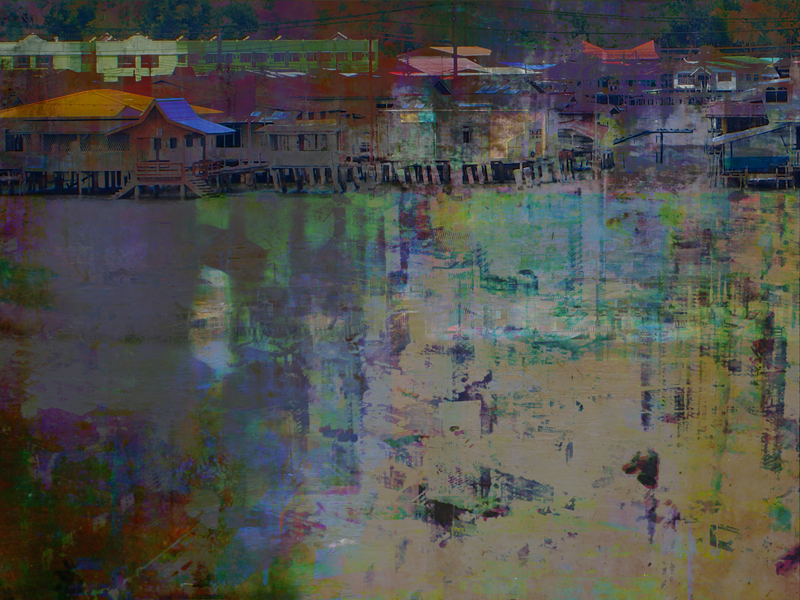Re: Development
2011
Formally, Re: Development employs mixed-media processes, photographic documentation mediated by painted intervention and digital technologies. The images explore the dichotomy of the contemporary landscape, and are intended to record the rapid transformation of today’s urban fabric and to comment on the juxtaposition of opposites – the old and historic vs. the new and contemporary, the natural vs. the constructed environment. While the images acknowledge the transformation of the contemporary environment, they also allude to mnemonic traces from the past, which while lost, are nevertheless an integral part of the contemporary landscape.
Re: Development, New World, oil paint and archival ink on disband, 36” x 48”, 2011
Re: Development, Brunei, oil paint and archival ink on disband, 36” x 48”, 2011
Re: Development, Brunei Toxic, oil paint and archival ink on disband, 36” x 48”, 2011
Re: Development, Brunei Fires, oil paint and archival ink on disband, 36” x 48”, 2011
Re: Development, Brunei Lost 2, oil paint and archival ink on disband, 36” x 48”, 2011
Re: Development, Brunei Lost 4, oil paint and archival ink on dibond, 36” x 48”, 2011
Re: Development, Brunei Lost 5, oil paint and archival ink on dibond, 36” x 48”, 2011
Re: Development 4, oil paint and archival ink on dibond, 36” x 48”, 2011
Re: Development, Night, oil paint and archival ink on dibond, 36” x 48”, 2011
Re: Development, installation shot, oil paint and archival ink on dibond, 36” x 48”, 2011
Displacement
2010
Displacement addresses the image of urbanity and our relationship to the built environment in which we live. The transformation of environment, understood nostalgically as a shift from natural to man-made, can be experienced as both “place” and “displace”. The work attempts to question how memories and images live in our conscious and unconscious, affect our ways of seeing and perception of reality, and define our understanding of place. Rather than being a dramatic narrative, the work questions history, the construction of time as a lineal process, and the distinction between the real and the virtual.
Apartment Facade, chromogenic print, 42’ x 42”, 2010
Beijing View 1, chromogenic print, 42’ x 42”, 2010
Brunei Lost, chromogenic print, 42’ x 42”, 2010
Lost Dimensions
2009
Lost Dimensions addresses the rapidly shifting dimensions of the contemporary urban spaces we inhabit. The work employs mixed-media processes — photographic documentation mediated by paint and digital technologies. The photographic fragments in the work have been shot in multiple locations, specifically in Beijing and Shanghai, and serve as mnemonic traces of time and place. Ultimately these images are are a lament to the loss of the natural environment, the destructive potential of built urbanity, and the loss of cultural specificity.
Lost Dimension 9, oil paint on board and digital print on plexiglas, 42” x 42”, 2009
Lost Dimension 11, oil paint on board and digital print on plexiglas, 42” x 42”, 2009
Lost Dimension 12, oil paint on board and digital print on plexiglas, 42” x 42”, 2009
Lost Dimension, installation shot, Yuanfen New Media Space, Beijing, 2009
Lost Dimension, installation shot, Newzones Gallery of Contemporary Art, Calgary, 2009
Mnemonic Structures
2008
In Mnemonic Structures, fragments of photographic images serve as traces of memories of places seen or imaged. These photographic fragments are intentionally vague and ambiguous as to their exact location in time or space, alluding to the uniformity of the contemporary urban environment we live in, with its seeming loss of cultural specificity and regional distinction. The architectural grid, the underlying structure of contemporary architecture, is seen as metaphoric of the universal conformity of the urban landscape.
Mnemonic Structure 6, oil paint on board and digital print on plexiglas, 42” x 42", 2008
Mnemonic Structure 8, oil paint on board and digital print on plexiglas, 42” x 42", 2008
Mnemonic Structure 13, oil paint on board and digital print on plexiglas, 42” x 42", 2008
Mnemonic Structure 16, oil paint on board and digital print on plexiglas, 42" x 42", 2008
Mnemonic Structures, Installation shot, Leo Kamen Gallery, Toronto, 2008
CCCA Profile
Sarah Nind (Centre for Contemporary Canadian Art) http://ccca.concordia.ca/artists/artist_info.html?languagePref=en&link_id=1614






















